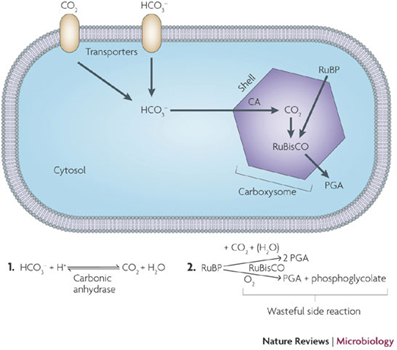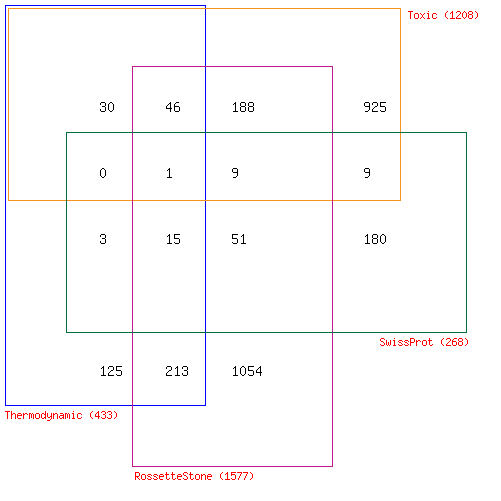Team:TorontoMaRSDiscovery/Bioinformatics
From 2009.igem.org
(→Future Directions) |
|||
| Line 55: | Line 55: | ||
=Future Directions= | =Future Directions= | ||
| + | [[image:TMDT_Comparison.jpg|right|thumb|Figure 2: Table containing cross-sections between thermodynamic, toxic intermediate, SwissProt, and RossetteStone categories.]] | ||
Our ultimate goal is to exploit an understanding of bacterial microcompartments to design new microcompartments with modified properties or novel enzymatic activities, which could result in potentially useful applications in biotechnology. With those two objectives in mind, we attempted to address the following two questions using various bioinformatics tools: (1) What enzymes will benefit the most from enzymatic channeling? and (2) Is there any other alternative microcompartment chassis that could be explored for enzymatic channeling engineering? | Our ultimate goal is to exploit an understanding of bacterial microcompartments to design new microcompartments with modified properties or novel enzymatic activities, which could result in potentially useful applications in biotechnology. With those two objectives in mind, we attempted to address the following two questions using various bioinformatics tools: (1) What enzymes will benefit the most from enzymatic channeling? and (2) Is there any other alternative microcompartment chassis that could be explored for enzymatic channeling engineering? | ||
| Line 67: | Line 68: | ||
Based on these three premises, the following enzyme tables were constructed: | Based on these three premises, the following enzyme tables were constructed: | ||
| + | |||
*Thermodynamic properties: | *Thermodynamic properties: | ||
Revision as of 01:50, 19 October 2009
| Home | The Team | The Project | Parts Submitted to the Registry | Modeling | Bioinformatics | Notebook |
|---|
Background information
Microcompartments:
Overview:
In nature, eukaryotic cells achieve different levels of organization by means of spatial segregation: proteins and chemicals are transported into and often retained within one of the many membrane-bound eukaryotic subcellular organelles, such as mitochondria, lysosomes, Golgi apparatus, etc. In bacteria, many cells can conditionally express proteinaceous microcompartments with similar function like eukaryotic organelles. These intracellular microcompartments are usually 100-150 nm in cross section [1]. They often consist of outer shells composed of thousands of protein subunits and functionally related enzymes in the core region[2]. This formation of microcompartment structure in bacteria allows cells to sequester specific metabolic pathways to enhance enzymatic efficiency and protect cells from the toxic effects of certain intermediates.
Classifications:
So far, most of our knowledge on bacterial microcompartments has been derived from the three well-studied microcompartment systems in nature.
- Carboxysomes
- First reported in 1956, carboxysomes were the first bacteria microcompartments to be discovered. They are often present in cyanobacteria and other chemoautotrophic bacteria [3]. They are known to play a key role in enhancing autotrophic carbon fixation in the Calvin cycle. The shell of the carboxysome encodes the enzymes carbonic anhydrase (CA) and ribulose bis-phosphate carboxylase monooxygenase (RuBisCO). CA converts bicarbonate ions into carbon dioxide, which is then converted into 3-phosphoglycerate (3-PGA) by RuBisCO. Carboxysome not only allows for co-localization of CA and RuBisCO, but also acts as a diffusion barrier to retain carbon dioxide in the immediate vicinity of RuBisCO and thus catalyzes the conversion [2].
- Pdu microcompartment
- In 1994, homologues of carboxysome shell proteins were reported in S. enterica. They are amongst a cluster of genes that are involved in coenzyme B12-dependent metabolism of 1,2 propanediol [4]. The gene cluster was later termed the pdu operon and the microcompartment formed was later termed propanediol utilization microcompartment. The proposed fuction of the pdu microcompartment is to encapsulate the enzymes that are necessary for cell to degrade propanediol and most importantly, to protect the cell from the toxic effects of propionaldehyde, an intermediate formed during the process [5].
- Eut microcompartment
- Later, similar structures were also found in E.coli and S. enterica when they were grown using ethanolamine as energy source. These structures were named ethanolamine utilization microcompartment (encoded by eut operon) and they often display very high genetic similarity with pdu microcompartment. Eut microcompartments contain enzymes involved in the degradation of ethanolamine and protect cell from acetaldehyde [6-8].
- Generally speaking, both pdu and eut microcompartments are less uniform in size and more irregular in shape than carboxysomes[2].
- Other putative microcompartment structures
- In addition to the three major systems mentioned above, several other putative microcompartments have been inferred from gene clustering analyses:
- A microcompartment was suggested to be involved in the oxidation of ethanol by Clostridium kluyveri. This was explored as an alternative platform to our current construction of encapsulin nanocomparment [9].
- A microcompartment associated with a puryvate-formate lyase homolog is proposed to be involved in the production of ethanol from pyruvate [10].
- A putative microcompartment in Rhodopirellula baltica is proposed to be associated with a lactate dehydrogenase homologue [1].
- A putative microcompartment in Carboxydothermus hydrogenoformans is associated with an isochorismatase-family protein [1].
- A putative microcompartment Solibacter usitatus can be associated with a dihydrdipicolinate synthase homologue [1].
Identification of conserved protein domain
Identification of new microcompartment is often achieved through bioinformatics analyses. (ie The pdu operon was first discovered as homologous to carboxysome genes.) The observation that diverse microcompartment structures are composed of proteins with homologous sequences led to the identification of a protein domain in the shell of all polyhedral bacterial microcompartments. This conserved protein domain, Pfam00936, is known as the Bacterial Microcompartment (BMC) domain. It is approximately 84 amino acids long and can be either found as a part of a large protein or in tandem copies within the same operon. This domain is found to be present in 189 bacterial species to date. [2]
Applications in nature
- Microcompartments are used to substantially catalyze a particular metabolic pathway by sequestering or co-localizing multiple metabolically related enzymes. This is true for all microcompartment structures discussed above because the product of one enzymes reaction will be in extreme vicinity to the next enzyme and will be delivered at high concentration as a substrate for the next enzyme. This prevents any potential diffusion loss of substrate and greatly enhances the enzymatic efficiency.
- Microcompartments are used to occlude toxic intermediates that cannot be degraded by normal bacterial machinery. This was shown to be true in pdu and eut microcompartments. The degradation pathway of 1,2 propanediol and ethanolamine both proceed through aldehyde intermediates (propionaldehyde and acetaldehyde respectively). The toxicity of these aldehyde intermediates was later shown in growth assays in which cells accumulating large amounts of propionaldehyde underwent growth arrest due to propionaldehyde toxicity [5, 11]. Therefore, it is reasonable to propose that bacteria are using microcompartment to mitigate the toxicity of aldehyde by encapsulating these poisonous intermediates.
Future Directions
Our ultimate goal is to exploit an understanding of bacterial microcompartments to design new microcompartments with modified properties or novel enzymatic activities, which could result in potentially useful applications in biotechnology. With those two objectives in mind, we attempted to address the following two questions using various bioinformatics tools: (1) What enzymes will benefit the most from enzymatic channeling? and (2) Is there any other alternative microcompartment chassis that could be explored for enzymatic channeling engineering?
1. What enzymes will benefit the most from enzymatic channeling?
We’d like to identify several enzyme pairs that display observable benefit from enzymatic channeling. Our approach to address this question is proposed based on the following assumptions:
- Enzymes pair with specific thermodynamic energetic properties will likely to benefit from enzymatic channeling. For two sequential reactions, the second one will be thermodynamically more favorable than the first reaction. Consequently, the products from the first reaction be consumed at a faster rate than being generated, hence driving the reaction to completion.
- Enzymes involved in reactions with toxic intermediates will likely to benefit from enzymatic channeling.
- Enzymes that were identified as gene fusion products in other organisms will likely to benefit from enzymatic channeling.
Based on these three premises, the following enzyme tables were constructed:
- Thermodynamic properties:
- Scored.csv: This is the list of all predictions based on free energy values.
- Toxic intermediates:
- ToxicPairs.tsv: Enzyme pairs that possess a common metabolite that is known to be toxic.
- Gene fusion or multicomplex proteins:
- RosettaEnzymePairs.tsv: The enzyme pairs predicted to form multifunctional enzymes by the Prolinks Rosetta Stone analysis.
- SwissProtPairs.tsv: The enzyme pairs annotated to form multifunctional enzymes in SwissProt database.
 "
"


